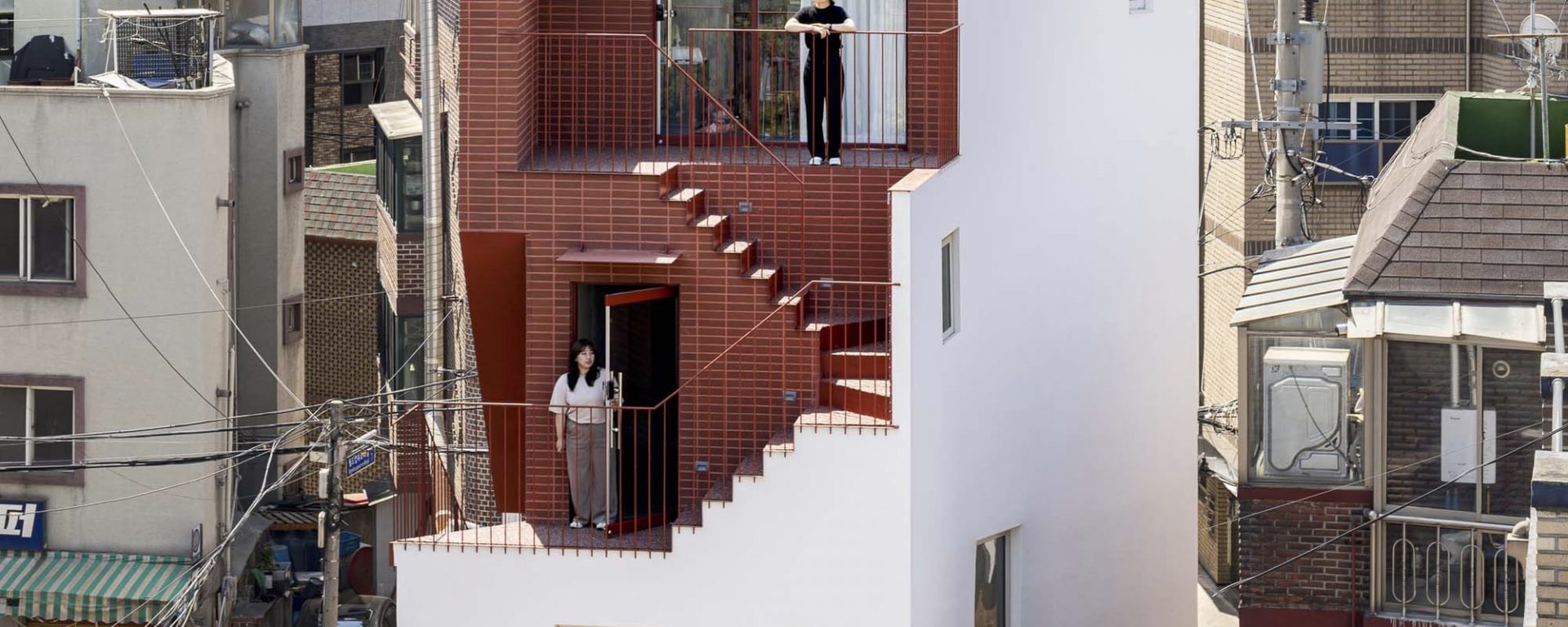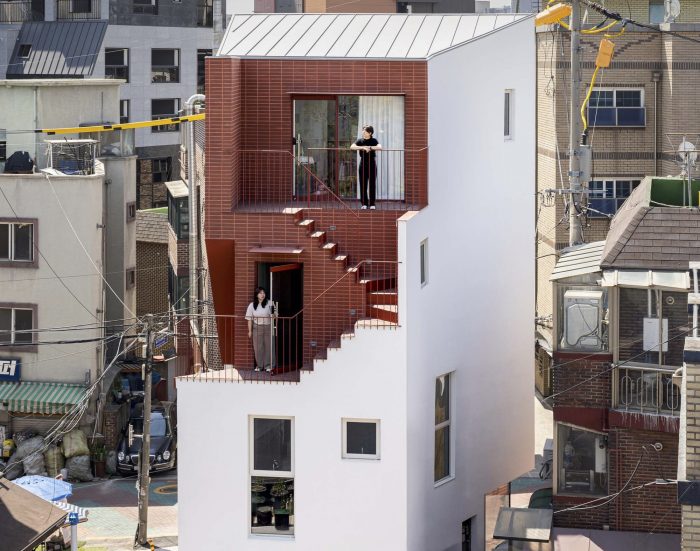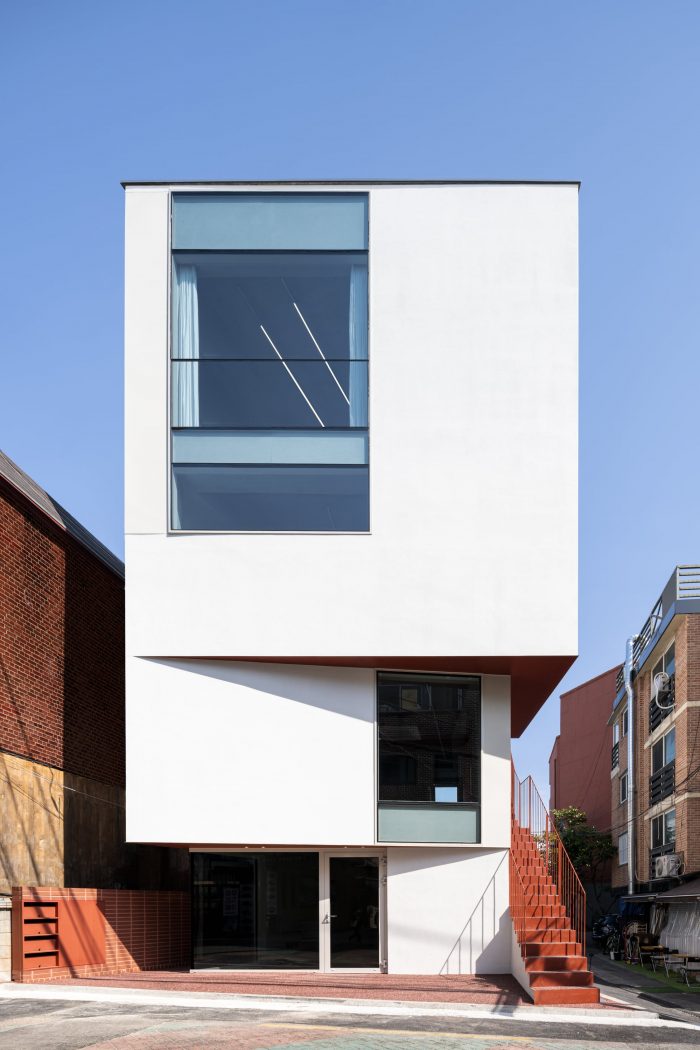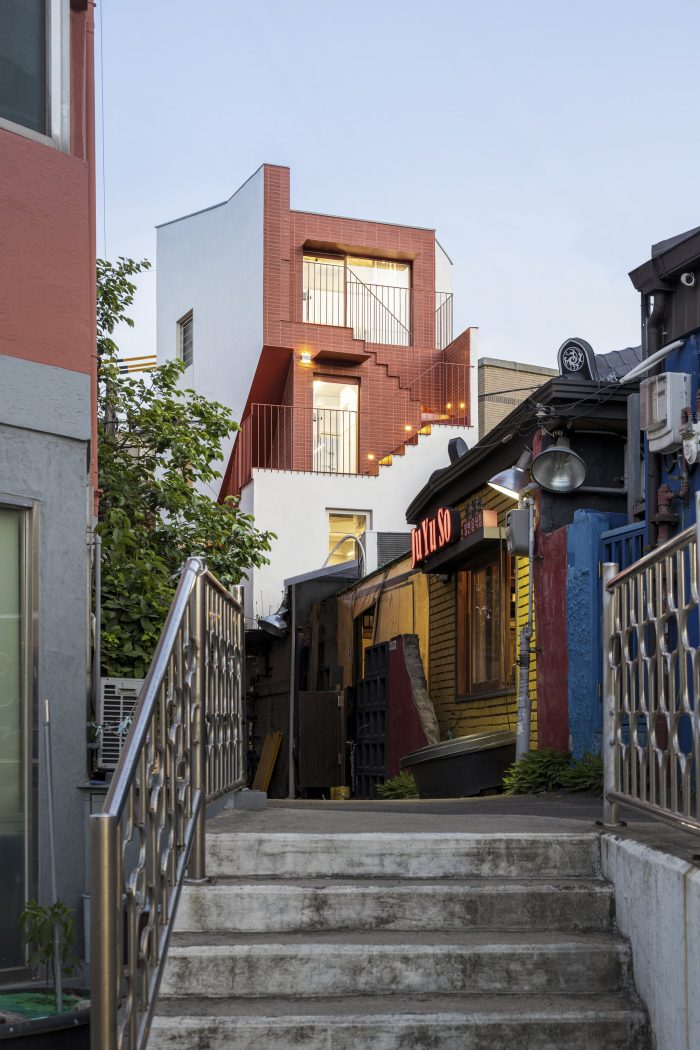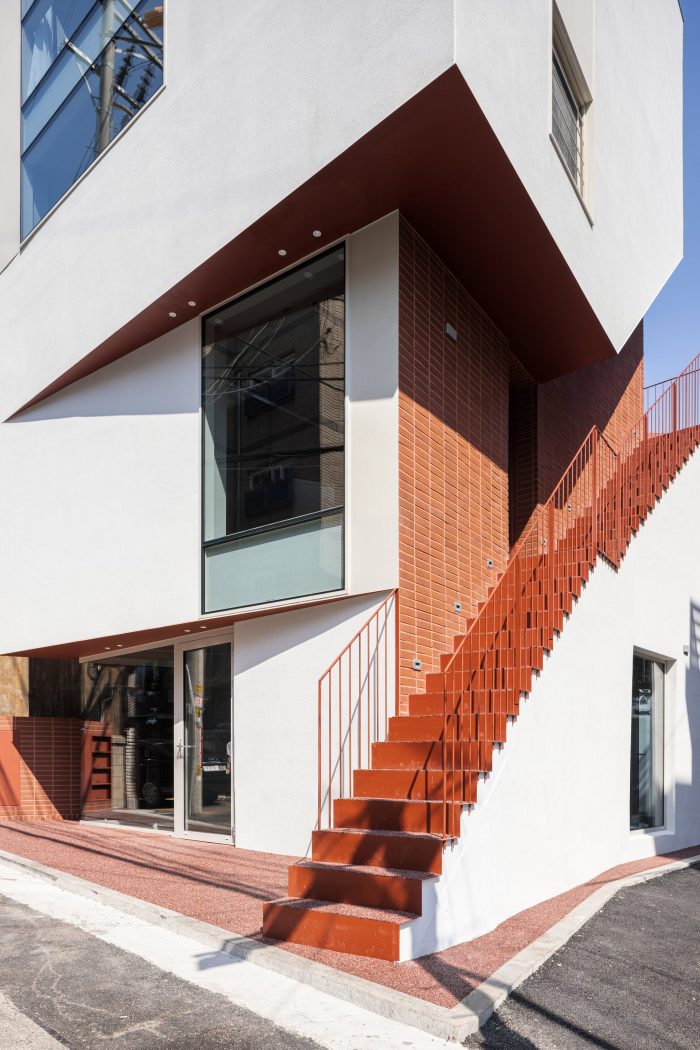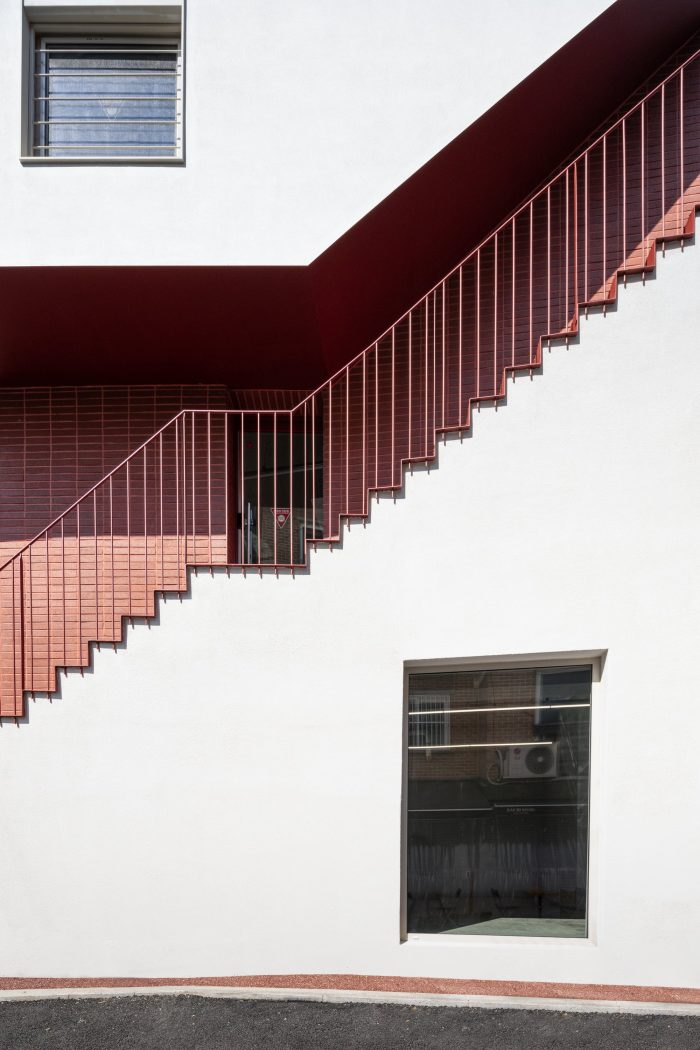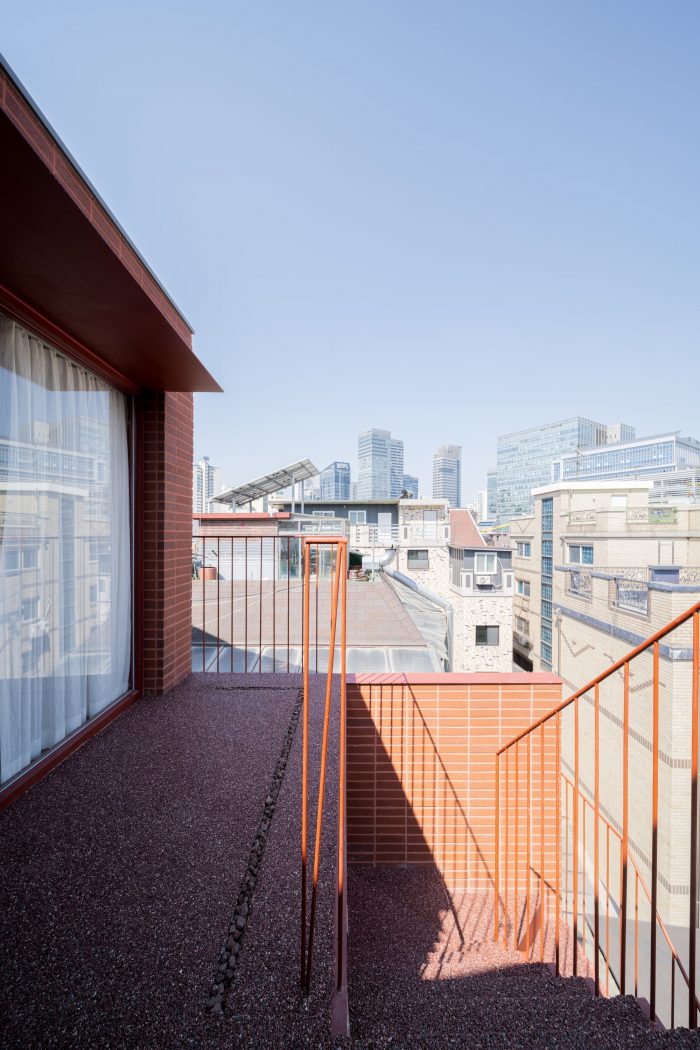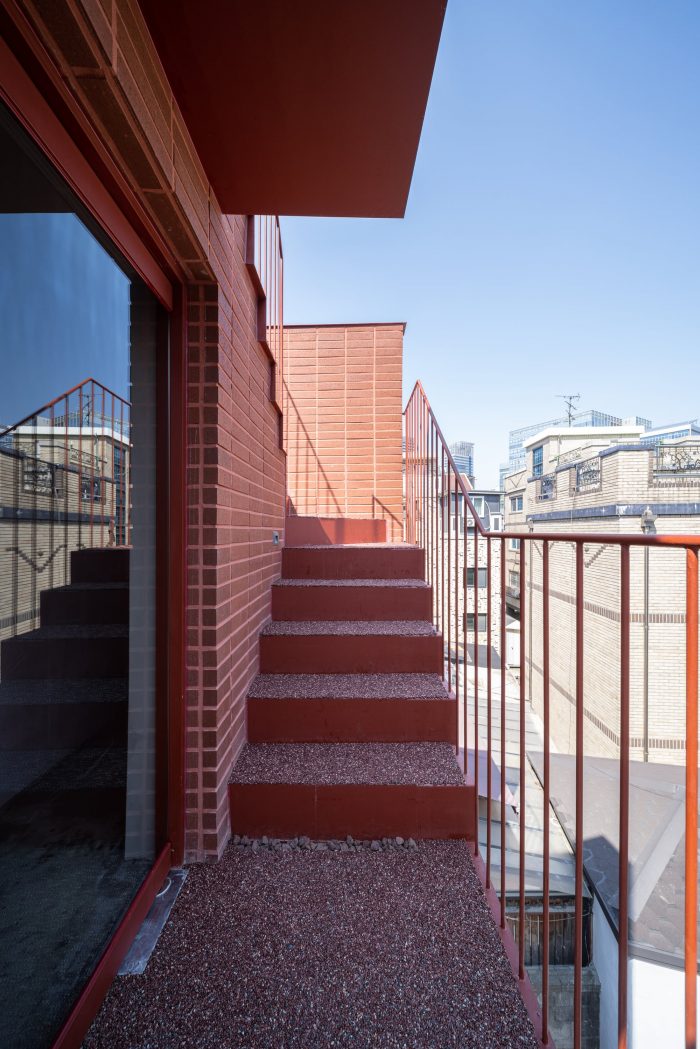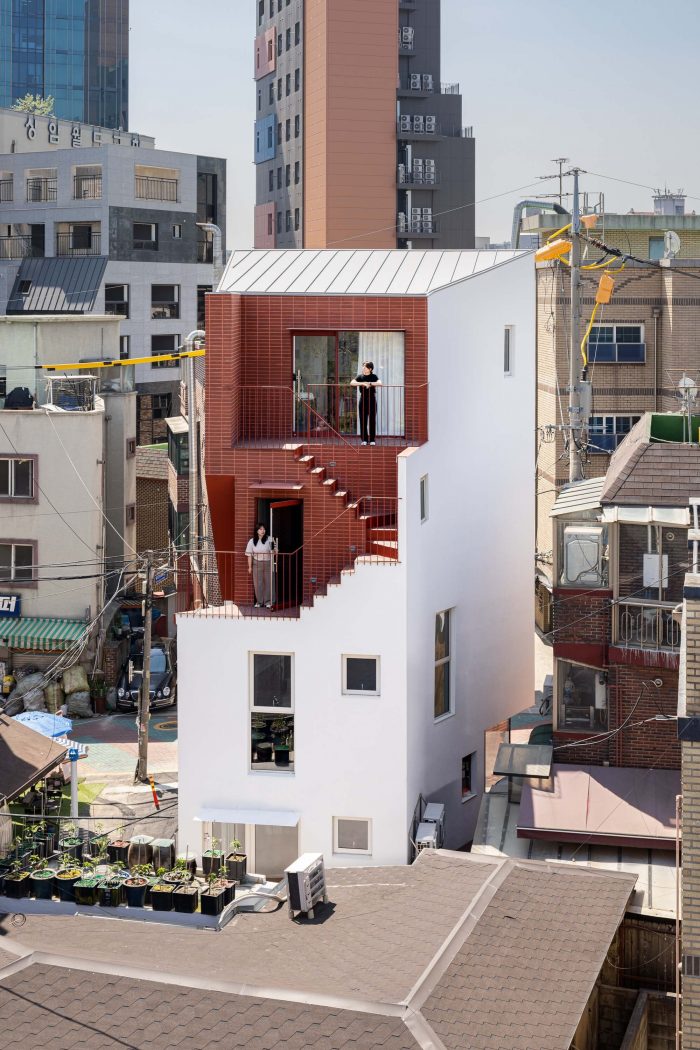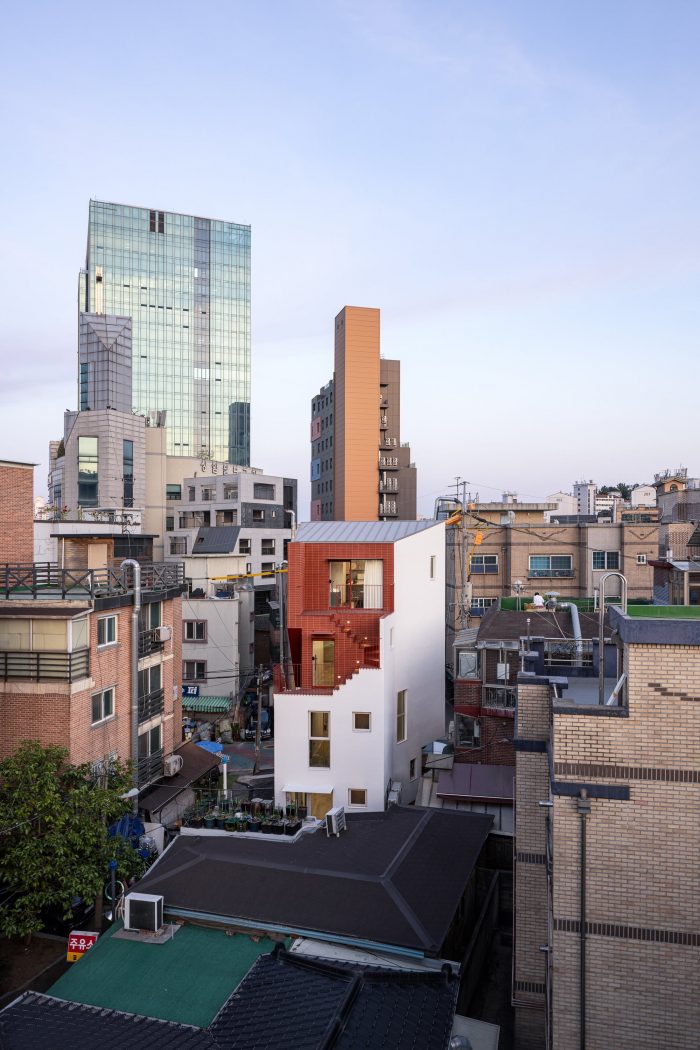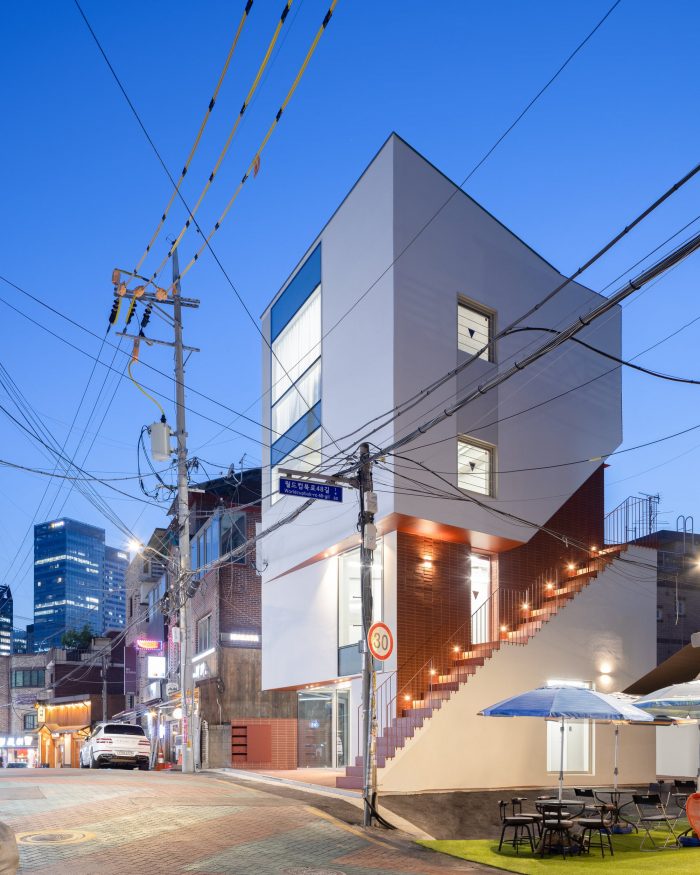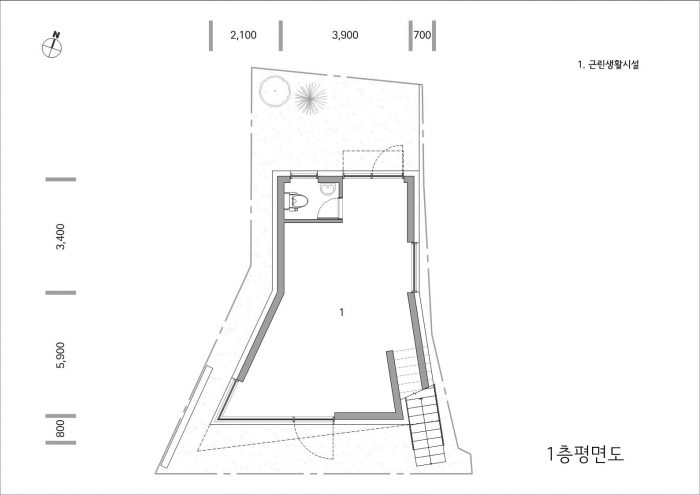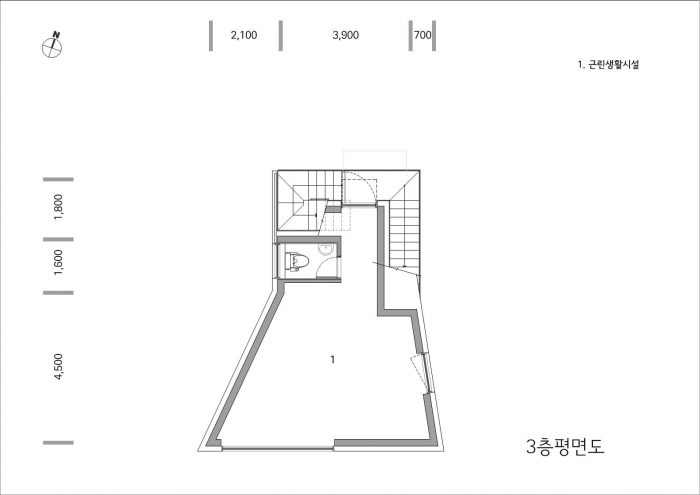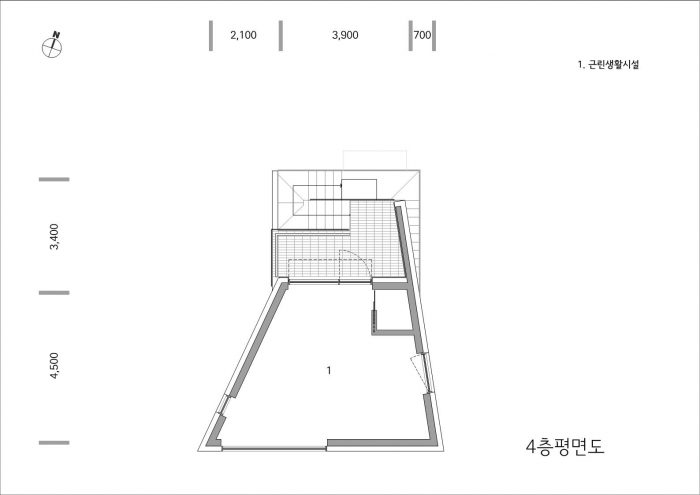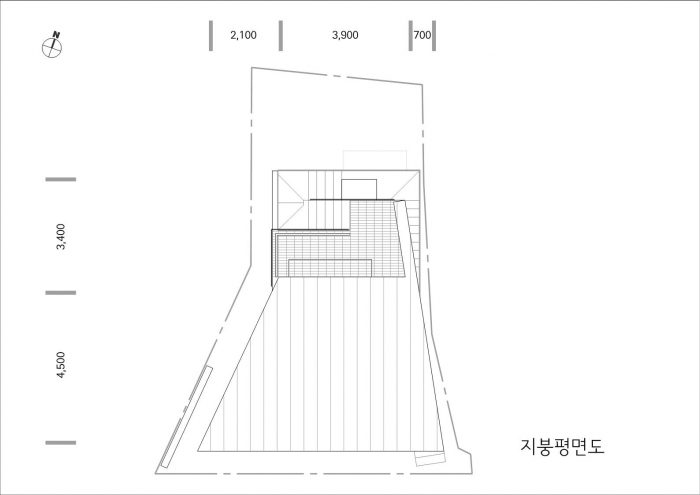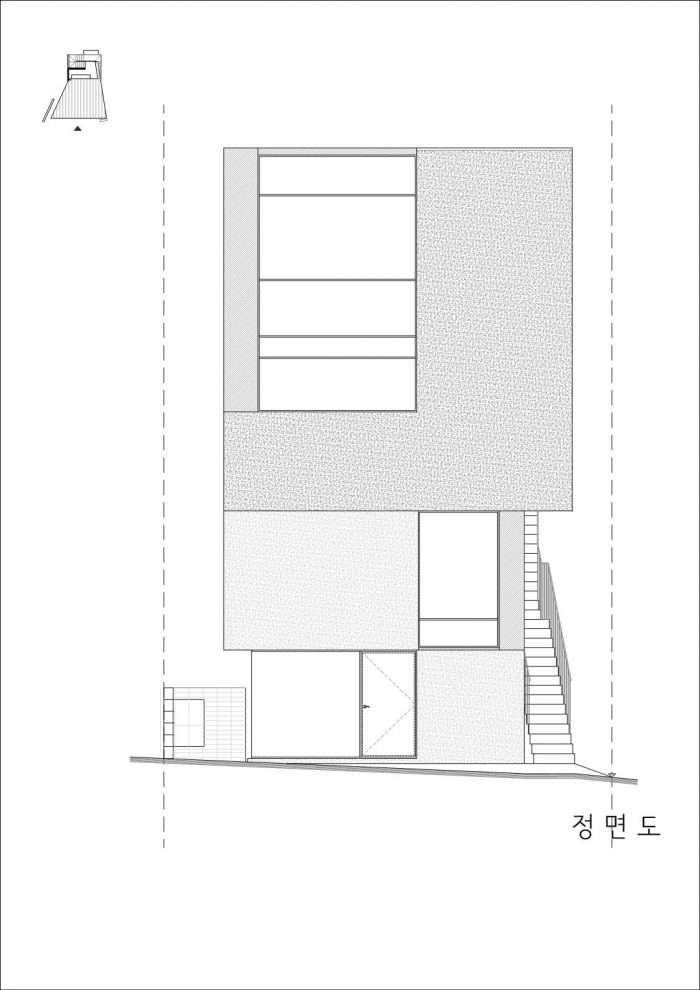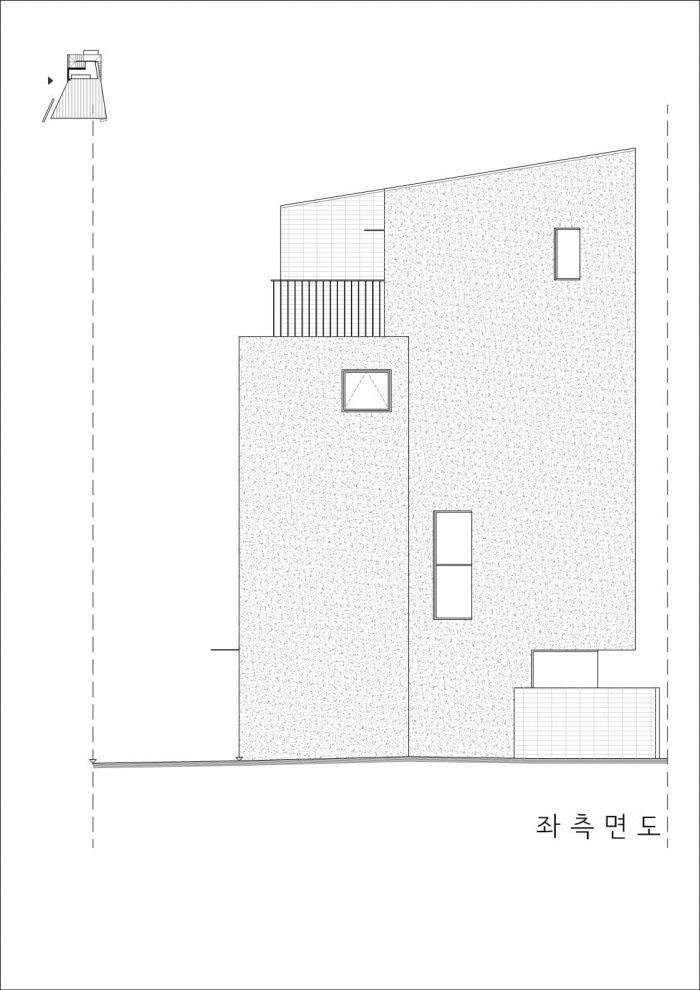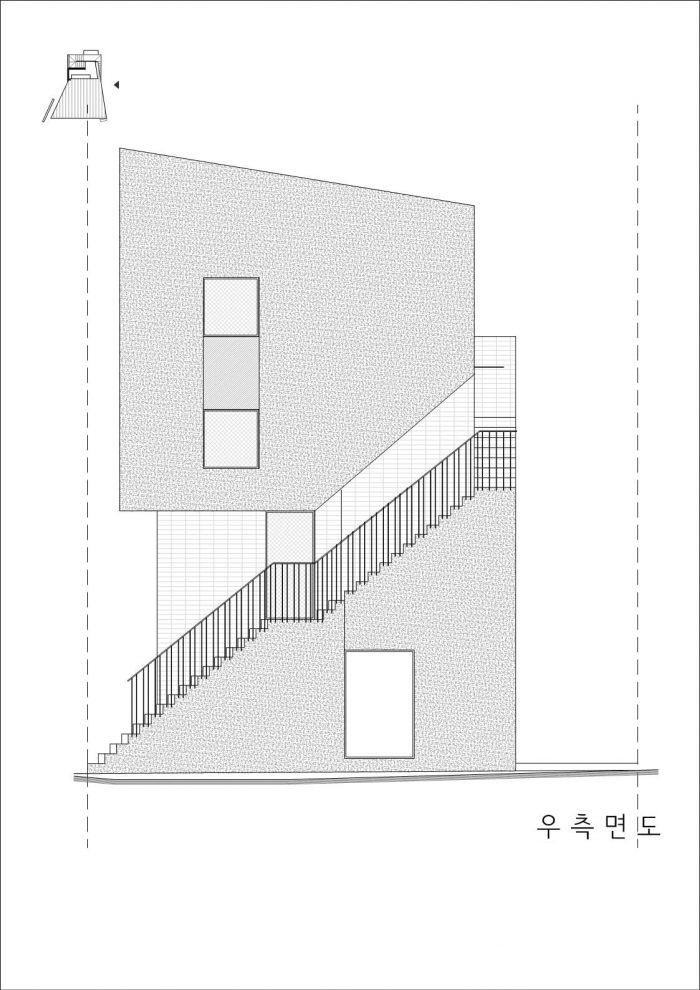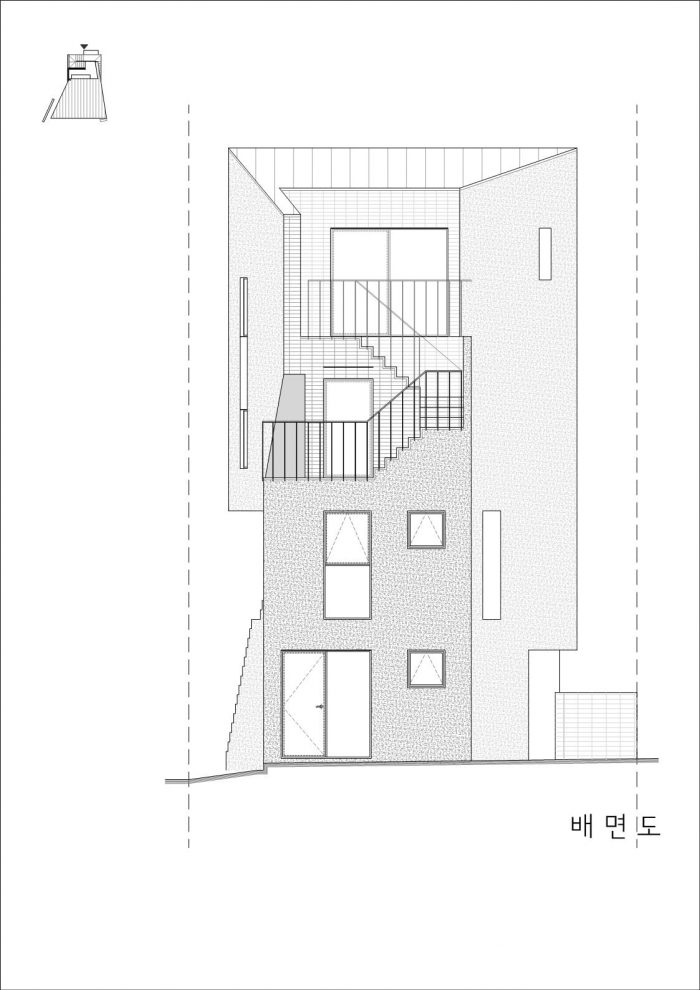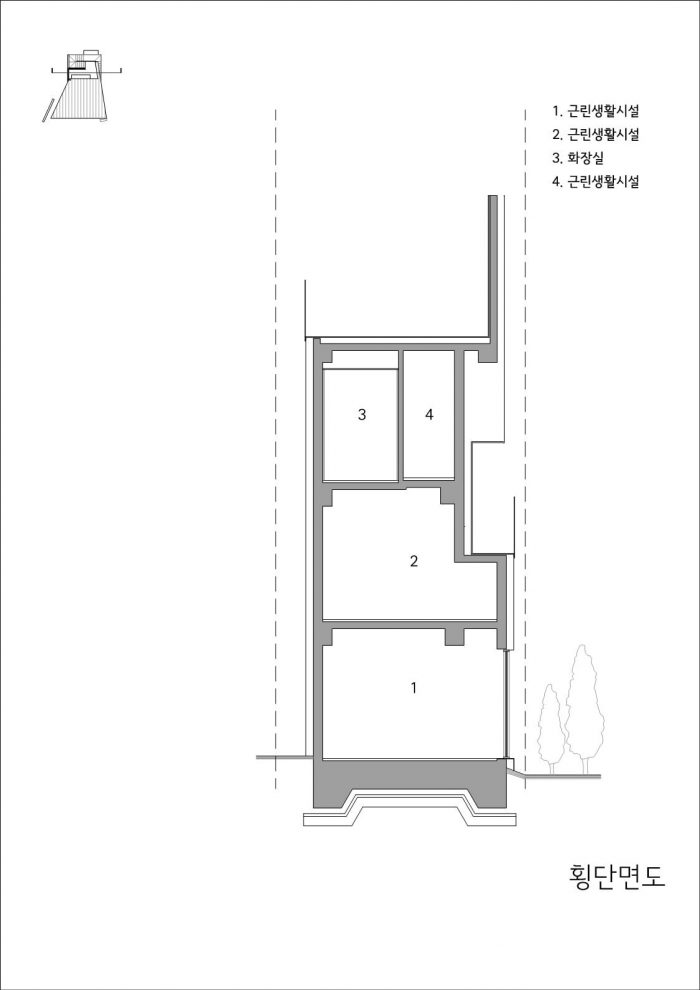上岩洞的小巷总是很繁忙。早上,他们挤满了赶着去上班或上学的人;下午,人们到这里的时髦餐馆和咖啡馆去;晚上,人们下班后会去喝一杯。名为 “红洞 “的小楼就矗立在这些小巷的某个地方。
The alleys of Sangam-dong are always busy. In the morning, they are packed with people hurrying to work or school; in the afternoon, with people visiting its hip restaurants and cafes; and at night, with people grabbing a drink after work. The little building by the name of Red Hole stands somewhere in the hustle and bustle of these alleys.
红洞所处的土地以前是在一栋无人居住的单层老房子下面。第一次访问这个地方时,让人感觉到时间在它周围停止了,这与机场铁路周围快速变化的环境形成了鲜明的对比。 它的面积为182平方米,位于一个街道的拐角处,不是最理想的,但这个建筑可以作为上岩洞繁华街道的门面。我们希望建立一个商业空间,自然地吸引路过的人们的注意和脚步,从而为街道增添一份活力。
The land on which Red Hole sits used to be under an old, unoccupied single-floor house. The first visit to the place made it feel as though time had stopped around it, in contrast to the surrounding environment changing rapidly around the airport railroad. Its area size of 182m2 and location at the corner of a street was not the most ideal, but the building could serve as the facade of the bustling street of Sangam-dong. We hoped to build a commercial space that naturally draws the attention and steps of people passing by, thereby adding a sense of liveliness to the streets.
与所有商业建筑一样,空间规划与盈利能力直接相关。我们首先要接受的是垂直延伸的多角形场地。我们决定在建筑和相邻的邻居之间留出一些空间,并在斜线限制下大幅开放空间,以获得日光。鉴于此,我们将确保最大的内部面积和可及性,以使其有利可图和实用。建筑物的中心将与外部融为一体,这样,楼梯下的空间也可以作为内部空间使用。由于斜线的限制,四楼的后面必须保持空旷,被设计成一个自然延伸到楼梯上的露台。因此,楼梯的动态设计和路径为街道增加了一种活力感。
As with all commercial buildings, space planning is directly related to profitability. We first had to come to terms with the multi-angular site that stretched vertically. We decided to allow some space between the building and its adjacent neighbors and dramatically open up the space subject to slant line restrictions for daylight. Given that, we would secure the maximum interior area and accessibility to make it profitable and practical. The center of the building would blend in with the exterior so that the space under the stairs may also be utilized as an interior space. The back of the fourth floor, which had to remain empty because of the slant line restrictions for daylight, was designed into a terrace stretching naturally onto the stairs. As a result, the dynamic design and path of the stairway add a sense of liveliness to the streets.
在规划室内空间时,最重要的因素是确保居住者能感受到一种开放的感觉。鉴于建筑的面积不大,从地板到天花板的窗户被放置在每一层的前面,以最大限度地提高这种开放性。一楼的拐角处的窗户,具有最好的可达性,被战略性地放置,以鼓励视线从外部自然延伸到内部。参观客户四楼美发店的顾客可以从美发店前面的落地窗和后面的露台欣赏到上岩洞的景色。
The most important element in planning the interior space was ensuring that the occupant can feel a sense of openness. Floor-to-ceiling windows were placed at the front of each floor to maximize this openness, given the building’s small area. The corner windows on the ground floor, with the best accessibility, were strategically placed to encourage the line of sight from the outside naturally extending to the inside. The customers visiting the client’s fourth-floor hair salon can take in the views of Sangam-dong from the salon’s front floor-to-ceiling windows and back terrace.
在决定外墙的颜色和外部材料之前,进行了大量的头脑风暴,以便使红洞成为该街道的象征。建筑物采用了简单的白色外墙,使它的小面积看起来比实际要大。楼梯和建筑的背面用红砖瓦覆盖以形成对比,使建筑像一块被咬掉的红丝绒蛋糕。红色被添加在外墙扭曲形式的缝隙之间,使其具有一点特色。由于这些立面元素,红洞已经转变为一个多边的建筑,提供了一种与众不同的感觉,给路人留下了持久的印象。
A substantial amount of brainstorming took place before deciding on the color of the facade and the exterior materials in order to make Red Hole a symbol of the street. The building adopted a simple white facade to make its small area appear bigger than it actually is. The stairs and the back of the building were covered in red brick tiles for contrast, making the building resemble a piece of bitten-off red velvet cake. The color red was added in between gaps in the twisted form of the facade to give it a little character. Thanks to these facade elements, Red Hole has transformed into a multilateral building offering a sense of distinction that leaves a lasting impression on the passers-by.
红洞最初是上岩洞街道上的一个封闭空间,现在已经成为该街道上最受瞩目和访问的建筑之一。我们预计,它将继续以 “红色楼梯房 “的身份被那些经过这条小巷的人所记住。
Having begun as a confined space on the street of Sangam-dong, Red Hole is now one of the street’s most gazed at and visited buildings. We anticipate that it will continue to be remembered as “the red staircase house” to those who pass the alley.
Architects: OHOO Architects
Area : 132 m²
Year : 2022
Photographs :Bae Jihun
Lead Architects : Seoyoung Noh, Haahlyn Kim
Structure Engineer : Hi Structurre Engineer
Design Team : Dongoh Kang, Seonghee Kim
Constructions : Bonzip
City : Mapo-gu
Country : South Korea

